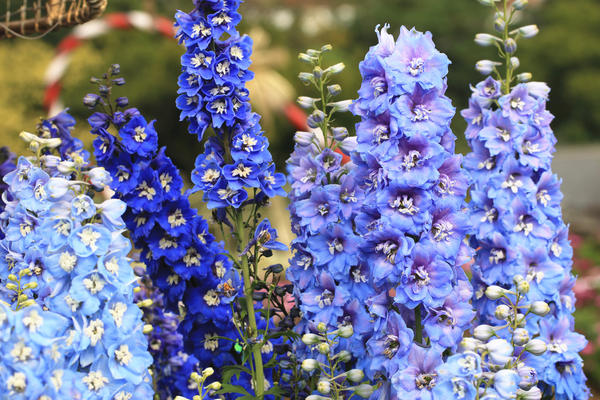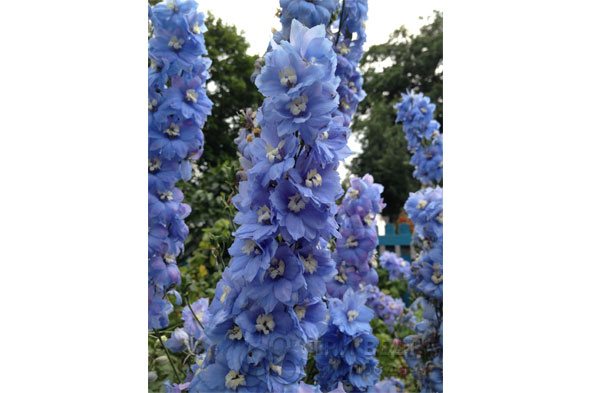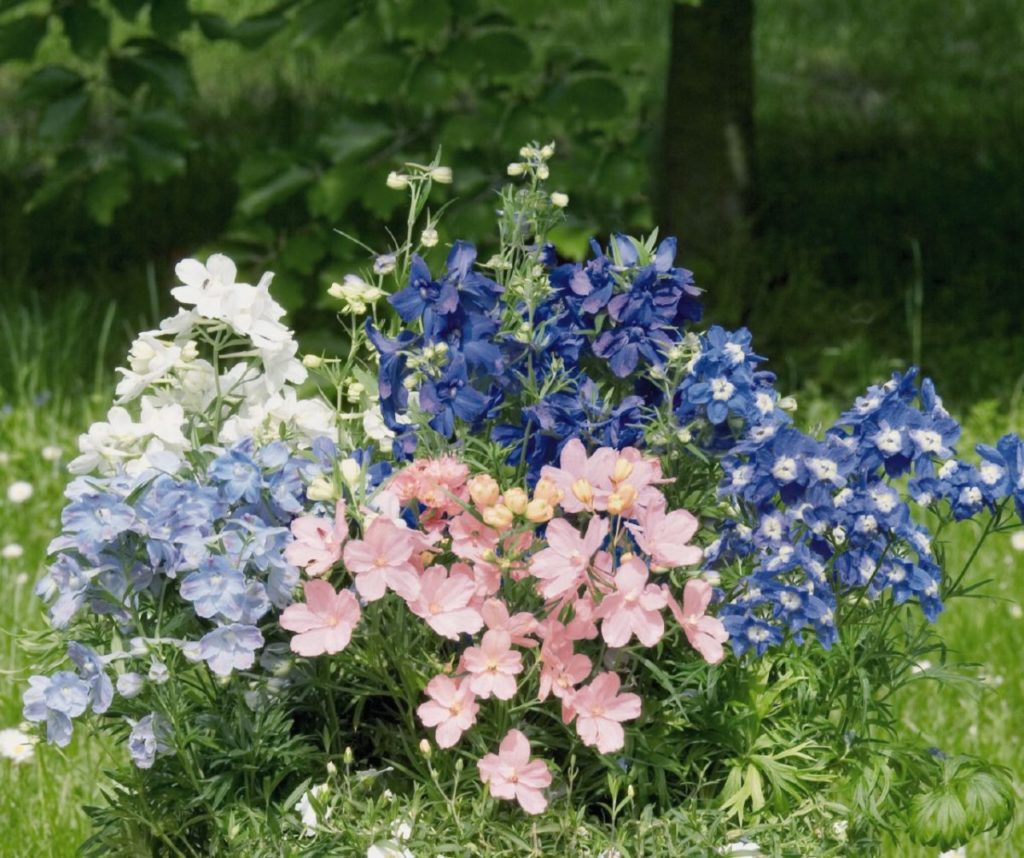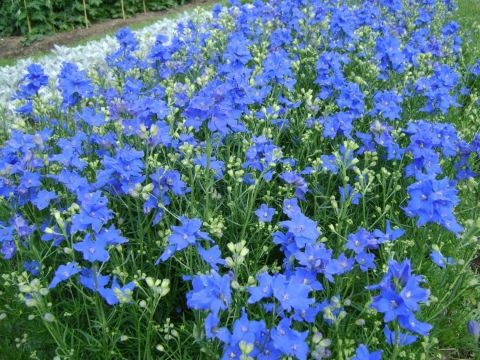Popular varieties
Breeders have developed a large number of varieties of Chinese delphinium, differing in the height and structure of the bush, as well as in the size, color and degree of doubleness of the flower brushes.
Among the popular and demanded are the following varieties:
- Blue butterfly. Small flowers up to 3.5 cm in diameter, bright blue or pure blue, are arranged in pyramidal inflorescences. Blossom in the first summer month and bloom until early September. The variety is suitable for decorating flower beds and flower beds, freshly cut brushes look good in bouquets. If faded shoots are removed in a timely manner, then re-flowering in the fall is possible.
- Pink butterfly. A low-growing plant, compact and graceful, shoots no more than 0.3-0.4 m in length. Spongy, loose, translucent inflorescences are strewn with small pale pink flowers about 3-3.5 cm in diameter.
- White butterfly. Leaky few-flowered brushes are white in color. The variety is often used for microborders in combination with other related varieties.
- Blue dwarf. The bush is about 0.3 m high with loose decorative corymbose clusters-inflorescences, which are made up of many rather small (up to 3 cm) bluish-blue flowers. The buds begin to open in early June.
On the shelves of specialized stores, you can find a mixture of large-flowered Butterfly Mix delphinium seeds, which allows you to get medium-sized bushes with brushes of various shades (white, blue, blue, pink).
3 Further care
After open ground transplants plants need to be given time to adapt, get stronger and grow. All care during this period is reduced to timely watering in the absence of regular rains, as well as loosening the soil at the base, which provides air access to the roots. If weeds appear, they should be removed in a timely manner. Subsequently, in order to avoid constant weeding and excessive evaporation of moisture from the soil, it is recommended to lay peat or humus mulch in a layer of 3 cm.
During the period when the bushes reach a height of 25-30 cm, it is necessary to thin out the shoots. For young seedlings, it is enough to leave 2-3 main stems, and for an adult bush - no more than 4-6 pieces. The rest of the stems are recommended to be cut at the base. This measure will help to achieve the formation of large inflorescences.
During the formation of buds, the second stage of feeding should be carried out. At this time, the plants no longer need a large amount of nitrogen, so it is recommended to use the following composition (for 1 bucket of water):
- 10 g of urea;
- 15 g superphosphate;
- 7 g of potassium sulfate.
During the flowering period, it is recommended to carry out the third feeding, using 20 g of superphosphate and 15 g of potassium sulphide per 10 liters of water. This procedure will help the plant prepare for the upcoming winter.
It is not recommended to use nitrogen fertilizers for delphinium in the second half of summer, as this leads to active growth of shoots and negatively affects the frost resistance of the bushes.
In autumn, when the flowering period is over and the leaves begin to wither, the delphinium bushes must be shortened at a height of 35–40 cm. The tops of the shoots should be covered with clay or garden varnish, since with heavy rains there is a risk of moisture getting into the middle of the shoot. This can lead to decay of the root collar.
Adult delphinium bushes and young seedlings are highly frost-resistant, therefore, they need to be covered with spruce branches only under the condition of a frosty and snowless winter.Most often, delphiniums suffer from sudden temperature changes and frequent thaws.
Features of the delphinium
Delphinium loves open sunny placesprotected from strong winds. In the sun, the petals can fade, so it is advisable to plant in a place that is in the shade for at least 2-3 hours a day.
Plant the delphinium in a windless place where there is shade for at least 2-3 hours a day. In the southern regions of Russia, the delphinium blooms in May-June, then again in the fall. And in the middle lane - from mid-June to the end of July and in autumn (again - only if you cut the flower stalks immediately after the first one).
Delphinium is a very winter-hardy plant, it can withstand frosts down to -40 ° C. Thaws are much more dangerous for him, because the root system lies close to the surface of the earth, so it can easily vanish. Try not to plant a flower in places where the first thawed patches form in spring.
Delphinium large-flowered in landscape design
Delphinium bushes are widely used to create mixborders and various flower ensembles in flower beds. Low large-flowered spurs are planted in the middle of the composition next to phloxes, irises, poppies, lupins and other crops. Small outbuildings or garden hedges are decorated with dense and lush flowering stems. The single plantings of the delphinium also look interesting.
The medium-sized Chinese burgundy creates a wonderful accent in the center of the flower group on the lawn or near ornamental shrubs (almonds, jasmine, barberry, etc.), as well as on the high bed along the garden path. Low-growing varieties are planted as a border along the edges of flower beds and paths. They are used in the design of decorative containers and flowerpots installed on balconies, terraces and outdoor areas in the garden.
Miniature delphiniums look great in rocky gardens and rockeries. Almost all varieties of this plant are harmoniously combined with roses, lilies, dahlias, asters, rudbeckia, and also with large cereals. The large-flowered variety of larkspur is used for cutting. Inflorescences in bouquets are able to maintain freshness for 7-10 days.
{SOURCE}
Delphinium groups and varieties
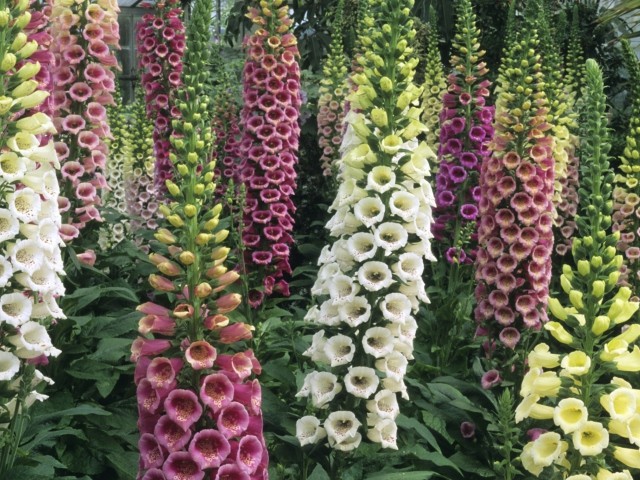
“Elatum Group”- includes varieties from 150 to 180 cm in height, obtained by hybridization of different species of delphinium with high delphinium. The inflorescence is pyramidal, up to 70 cm thick, with large, often semi-double flowers (up to 8 cm). Bloom almost all summer. Some varieties bloom again at the end of summer.
“Pacific Hybrids Group”- the tallest varieties (200 cm and more); panicle shape - dense pyramidal with large inflorescences, in which double flowers are collected. They were obtained by the Californian breeder F. Reinelt by selection during self-pollination and hybridization. They bloom in early to mid-summer, sometimes again in August. Varieties of this group are especially susceptible to diseases and are grown as one and biennials. (Varieties: Vomit Jay, Summer Skies, Black Night, King Arthur, etc.)
“Group "Marfinsky hybrids”- founded by the Russian botanist N. Malyutin. The name comes from the name of the village where the selection work took place - “Marfino”. Highly decorative with good frost resistance, take root well in central Russia. At a height of 180 cm - 100 cm occupies a dense inflorescence with semi-double flowers. Delphiniums come in a wide variety of colors. (Varieties: Spring Snow, Morpheus, Blue Lace, etc.)
“Belladonna group”- was founded by the Dutchman Ruys by crossing tall and large-flowered delphiniums. Plant height ranges from 80-120 cm, up to 180-200 cm. The inflorescence consists of five or more large, more often semi-double flowers, often blue-blue colors with narrowly dissected leaves. (Varieties: Casablanca, Bellamosum, Semiplena, etc.)
“New Zealand hybrids”F1 are part of the Elatum Group. Created by New Zealander T. Daudeswell. The height of these varieties is 150-220 cm, with large (up to 10 cm) double (semi-double) flowers arranged in several rows (up to 24 petals), sometimes with corrugated edges. Long-flowering, frost-resistant, not susceptible to diseases of the variety, are currently the most common and favorite delphinium of gardeners in the world. (Varieties: Sunny Skies, Dusky Maidens, Green Twist, Sweethearts, etc.)
“Scottish Hybrids Group”Are delphinium varieties with super-double flowers. Scottish breeder T. Cockley created delphinium varieties that have won the love of flower growers with their beauty. The growth of the bush is from 110 to 150 cm, while the inflorescence reaches 80 cm, very densely collected from large flowers, which can number up to 60 petals. Frost resistance, a wide variety of colors and decorativeness makes varieties of this group are the most popular... (Varieties: Moon Light, Crystal Delight, Moning Sunrise, etc.)
Origin of the name and classification of delphiniums
The Latin name of the flower delphinium is accepted in floriculture all over the world, although the term larkspur is more common in Russian scientific literature. The origin of the Latin name is associated with the similarity of the shape of the bud with the structure of the body of a dolphin, according to another version - with the Greek city of Delphi, where the plants were widespread. The Russian version, larkspur, reflects its use in the practice of traditional methods of treating fractures. There is another, outdated name - spur, given for the characteristic features of the structure of the flower.
The genus includes annuals and perennials. One-year delphiniums include about 40 species, of which two are grown in decorative floriculture: field and Ajax.

Wild-growing delphinium in the photo
Perennial delphiniums, in turn, are divided according to the place of growth into Eurasian, American and African.
Hybrid delphiniums are distinguished into a separate group; it includes the vast majority of varieties grown in gardens.
Below are descriptions and photos of delphiniums of some decorative species and varieties, grouped in accordance with the above division.
Diseases and pests of delphiniums, measures to combat them
For the prevention of diseases, delphinium can be regularly (once every 2-3 weeks) sprayed with the “Healthy Garden” preparation. The most common disease is powdery mildew. Instead of "Healthy Garden", in the spring, when the stems grow back, you can spray the plantings with a 1% solution of any preparation containing copper (Bordeaux liquid, copper sulfate, copper oxychloride) or with the preparation "Epin-extra", which at the same time will protect the plants in case of sudden frosts. In addition, in the fall, after cutting (or directly on the plant), repeat the spraying.
Of the pests, the delphinium is attacked by a fly, a scoop, a spider mite. With regular spraying with "Healthy Garden", the pests of the plant do not touch. But if you do not have this drug, then spray it every three weeks with Fitoverm or IskraBio, starting from the moment the cherry blossoms. By the way, self-defense of any plants is enhanced by regular feeding (once every 2-3 weeks) with organic fertilizer "Gumi" or microbial fertilizer "Extrasol".
Of the pests, the delphinium fly can attack delphiniums. The fly does not like peat, and therefore, when mulching the soil with peat, it will fly around the delphiniums. Sometimes the ends of the shoots are inhabited by aphids. Perimor works well against it, as well as preventive spring spraying with Healthy Garden (2-3 times in May – June). Of the diseases, powdery mildew is most often observed in a humid summer (do not water on the leaves, and it will not happen). But the plant cannot be protected from the rains, so you will have to use blue spraying (with Bordeaux liquid, "Hom", copper sulfate) or use "Zircon", "Bravo", soda ash (3 tablespoons per 10 liters of water).
Sometimes black spot or bacterial wilting appears.In both cases, "Fitosporin" or "Zircon" helps well.
The following describes how to propagate delphiniums in the garden.
Views
- Delphinium cultural - Delphinium x cultorum;
- Delphinium red - Delphinium cardinal;
- Larkspur sinuous - Delphinium flexuosum;
- Delphinium large-flowered - Delphinium grandiflorum;
- Delphinium holosteel - Delphinium nudicaule;
- Gloomy larkspur - Delphinium triste;
- Delphinium high - Delphinium elatum;
- Tatra larkspur - Delphinium oxysepalum;
- Sichuan larkspur - Delphinium tatsienense;
- Delphinium Bruno - Delphinium brunonianum;
- Delphinium Ajax - Consolida ajacis.
At home, it is worth growing primarily a cultural delphinium, it has numerous variable series, differing in inflorescence, inflorescences of varieties reach 1 meter long... Various plant heights and colors, give great opportunities for the selection of plants and use in various compositions. In addition to the cultural delphinium, it is worth planting a large-flowered delphinium in the garden, the undersized species looks great in containers.
Less common is a tall delphinium growing in thickets, forest outskirts, meadows, at the foot of the mountains. The Tatra delphinium (Delphinium oxysepalum) and the holosteel (Delphinium nudicaule) also look interesting.
Delphinium transplant after purchase in open ground
Growing a delphinium in a garden is possible subject to the conditions necessary for this. When properly cared for, a plant can boast lush blooms and impressive, tactile leaves.
When buying a plant, it is important to follow the rules for transferring it from a pot to open ground.
What is needed for landing
There is an opinion that delphiniums are perennial, planting andcare for which do not require special conditions, yet should be studied before breeding in a garden. It is worth preparing for planting a plant. The stages of preparation will be:
- choice of location;
- purchase of seeds or ready-made seedlings;
- purchase of equipment, if necessary (shovels, special gloves, devices for loosening the soil, fertilizers).
After the preliminary stages have been passed, and the soil is prepared, you can proceed directly to planting.
Choosing the best place
The place where the flower can be planted should be sunny and sheltered from the wind. If you place a tall plant in a blown area of a flower garden, you can sooner or later observe broken stems. After this, it will not work to return the plantings to life, you will have to acquire new seedlings.
Attention! It is best to choose an area where it is sunny in the morning, shade during the day, and sunny again in the evening. If the shadow period during the day is more than sunny, you should not count on lush bloom.
The flowers will most likely not be as bright and impressive.
If the shadow period during the day is more than sunny, you should not count on lush bloom. The flowers will most likely not be as bright and impressive.
The soil in the area for planting should be fertile, humus, moderately moist and permeable. It is a known fact that "spurs" can grow on clay soil. When it comes to sandy soil, it is necessary to prepare it in advance, to increase fertility and the ability to absorb water.
Step-by-step planting process
Delphinium planting takes place in several stages.
It is important to observe them so that the plant looks great as it grows:
- Clear the area before planting from weeds.
- Soak the seeds of the plant in a fungicide solution or a weak manganese solution for half an hour.
- Rinse the seeds that have passed the disinfection procedure with running water, dip them into the stimulant mixture.
- Dry the seed.
- Sow seeds into the ground in boxes, taking care of their measured distribution.
- Sprinkle them from a spray bottle.
- Cover the seeds with foil, place them on the windowsill closer to the window pane.
- Moisten the soil from time to time.
- Plant the seedlings in the ground as soon as 2-3 stalks appear on the sprouts.
Important! Planting seeds for seedlings takes place in winter, and placement of seedlings in the open field - in spring. When planting sprouts, it is worth remembering that the distance between them should be at least 35-50 centimeters. To normalize the soil, greenhouse soil or its mixture with compost is placed in the replanting pits
This will help protect the plant from diseases, make it more resistant to the harmful effects of external factors. It is recommended to cover seedlings with transparent jars at first. After a couple of days they are removed for good.
When planting sprouts, it is worth remembering that the distance between them should be at least 35-50 centimeters. To normalize the soil, greenhouse soil or its mixture with compost is placed in the replanting pits. This will help protect the plant from diseases, make it more resistant to the harmful effects of external factors. It is recommended to cover seedlings with transparent jars at first. After a couple of days, they are removed for good.
Growing and care
Delphinium is a gorgeous, albeit short-lived, perennial plant that, in addition to gorgeous flowers, boasts impressive, tactile leaves. In order for the plant to grow well, it is necessary to provide suitable growing conditions and care for the perennial delphinium.
Higher varieties of larkspur require the use of supports.

After flowering, it is recommended to remove the shoots with inflorescences, then there is a high probability that they will bloom again in late summer - early autumn.
Landing requirements
Delphinium should be grown in sunny places, sheltered from the wind (especially tall varieties)
This is important, long stems are quite fragile and can break from strong gusts of wind. Larkspur can grow in partial shade, but will produce less impressive inflorescences
Positions where the sun's rays fall in the morning are better suited, in the afternoon there is a slight shadow.

Delphiniums prefer soils with the following characteristics:
- fertile,
- humus,
- moderately wet
- permeable.
Larkspur can be grown on clay soils. Sandy soil is unsuitable, so you need to work on it in advance to increase fertility and absorption (water absorption). An alkaline or neutral soil reaction is optimal for most larkspur species.
Landing
Before planting a delphinium, you need to carefully prepare the site - clear it of weeds, dig it up. In autumn, when digging, it is recommended to mix the garden soil with rotted manure and compost.
Perennial delphinium is grown from seeds. You can sow the seeds in advance in boxes for seedlings, but usually they are sown directly into the ground.

The average interval is 30-40 × 30-40 cm (depending on the species and individual characteristics of the variety). Larkspur needs a lot of space. Plants planted too tightly drown out each other, which increases the susceptibility of flowers to certain parasites and diseases (powdery mildew, snails).
Wintering
The frost resistance of the delphinium is quite high. Sensitive varieties and young seedlings are recommended to be covered with needles, non-woven material or sprinkled with leaves in winter.
Problems can be created not so much by frosts as by variable weather, snowless winters. Larkspur grown in containers must be carefully covered or moved to a cool place for the winter.

Watering, fertilizing
Delphinium should be watered if there is no rain for a long time. Young seedlings require regular watering
Water should be done carefully, without splashing leaves or flowers. Larkspur responds positively to soil mulching
In the case of organic fertilization, the use of mineral fertilizers is not necessary. If organic fertilizers are not applied, mineral fertilizers with a high content of potassium and phosphorus are applied.
After the first flowering in early summer (June), the plants need to be fed with compost and cut off the inflorescences at a height of about 10 cm above the ground. Thanks to this, in the second half of summer, larkspur will decorate the garden with wonderful flowers.
Reproduction
The breeding method depends on the group:
- Reproduction by dividing the bush is often practiced. To propagate the delphinium in this way, an adult plant is dug up, trying not to damage the roots, it is divided and planted in a new place.
- In the case of generative reproduction (by sowing collected seeds), it is necessary to remember that seedlings sown with self-collected seeds do not completely duplicate the characteristics of the mother plant.
Diseases and pests
Prevention and protection of the delphinium from diseases and pests is largely based on proper care:
- plants can be periodically sprayed with plant infusions;
- hygiene is important - removal of plant debris after the season;
- you need to monitor the density of plantings - high density will not improve the appearance of flower beds, other plantings, increase the risk of infection, cause problems with pests;
- sometimes it is necessary to sprinkle the flower beds with broken eggshells or basalt flour to protect them from slugs, snails that adore larkspur.
Delphinium can be threatened by:
- blue-green larkspur aphid that feeds on delphinium (Delphiniobium junankianum);
- chrysanthemum nematode.

Larkspur can affect the following diseases
| physiological | yellowing or browning of leaves when grown on too light, quickly drying soil) |
| fungal |
|
| bacterial | black leaf spot |
Reproduction of delphinium
Delphinium can reproduce in several ways. Growing from seed is most commonly used in greenhouses and home gardens, but other methods are also used.
Cuttings
When propagating a delphinium by cuttings, it is important to follow a certain procedure:
- cut off apical cuttings at least 10 cm long in early spring;
- root cuttings in peat and sandy soil, mixed in equal proportions;
- plant the cuttings in the ground to a depth of 2 cm, cover them with plastic cans;
- keep the soil moist, make sure that the temperature under the jars is at least 20 ° C.
Rooting cuttings is a long process. You can open them after the plant takes root. Before planting them on permanent soil, at least a year should pass. Otherwise, the plants will die. The distance when planting plantings should be at least 30 centimeters.
From seed
Seeds can be bought from breeders, flower growers, or you can collect them yourself. Seeds are collected in several ways:
- sprinkle seeds from cracked bolls that are on the lower parts of the stem;
- the tops are cut and wrapped in a bag, and then placed with the crown down;
- the stems are cut and hung in a dry place for ripening if weather conditions have not allowed them to mature naturally.
It is recommended to store seeds in the refrigerator door at a temperature not exceeding 5 ° С.
By dividing the bush
The presented method of reproduction excludes the loss of planting material.
Attention! It is better to give preference to an adult plant, but young, with a well-developed rhizome. The division process takes place in several stages:
The division process takes place in several stages:
- a perennial is dug out of the ground, with a sharp tool its rhizome is cut;
- all old shoots and leaves are removed;
- the parts obtained during division are seated on the site, it is advisable to leave the kidneys on them.
This method of flower propagation is recommended for use in early spring or autumn.
By dividing the bush
Growing features
In order for the plant to please the gardener for many years, one should take care of the conditions in which it will grow comfortably.Delphinium is a light-loving flower, so shaded areas will not work for it
In a dense shade, the spur may simply die, this must be taken into account when choosing a place. The plant will signal the lack of light by deformation of leaves and buds, as well as a change in color.




The plant has rather fragile stems that can not withstand strong gusts of wind, this also needs to be taken care of when choosing a place. Planting is done where there will be no strong drafts. Otherwise, the delphinium is completely unpretentious and does not create problems for the gardener.
When growing a delphinium, some rules must not be forgotten. In general, they are standard and do not require large labor costs from the gardener. First of all, it is necessary to ensure timely weeding, as well as loosening the soil as needed.
Also, the plant does not tolerate prolonged drought, in hot and dry weather it will need to be watered regularly. To make the peduncles stronger, you will need to periodically thin out the shoots. Like any flower, the spur needs additional feeding. It is quite resistant to the occurrence of diseases and the invasion of pests, but in the presence of this trouble, it is necessary to take action in time.
For the intricacies of caring for a planted delphinium, see below.


